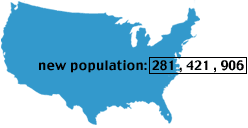First Results of Census 2000 Released

New figures put U.S. population at 281.4 million
by Ann-Marie Imbornoni |
 Population Links
More Related Links
More InformationThis year, a member of the House represents about 625,000 people. Apportionment is the process of determining the number of seats in the House of Representatives that each state is entitled to based on the census. Redistricting is the process of redrawing the boundaries of districts within a state from which people elect their representatives to various governing bodies, such as the U.S. House of Representatives and the state legislature. |
On Dec. 28, 2000, the U.S. Census Bureau released the first data from Census 2000, the country's 22nd decennial census.
The new figures show that the nation's resident population on Census Day, April 1, 2000, was 281,421,906, a 13.2% increase over the 1990 count of 248,709,873. The resident population includes both citizens and noncitizens living in the 50 states and the District of Columbia.
Change from 1990 to 2000
According to the new census figures, all the states increased their populations, but the most dramatic gains were seen in the southeast and western parts of the country. Nevada had the largest population gain, up 66.3% from 1990.
California remains the most populous state with 33.8 million people, up 13.8% from 1990. Texas, however, surpassed New York to become the second most populous state, with a population increase of 22.8% for a total of 20.8 million people.
Other states with population gains of more than 20% were Arizona, Colorado, Utah, Idaho, Georgia, Florida, North Carolina, Washington, Oregon, and New Mexico.
Census Used to Reapportion Congressional Seats
The census is the basis for determining the number of representatives each state has in the U.S. House of Representatives, as established by Article 1, Section 2 of the Constitution. States with larger populations have more representatives than states with smaller populations. Each state must have at least one representative.
Congress determines the number of seats in the House of Representatives, which is currently set at 435. The process of dividing the 435 House seats among the 50 states is known as apportionment. Every ten years the number of representatives a state is entitled to is reapportioned according to the new census figures.
Once the number of seats is assigned to each state, it is up to the individual state legislatures to redraw new congressional districts. Each representative is elected by voters from a congressional district within their state.
Who Counts?
The population figure used to calculate the apportionment of House seats is based on the total resident population of the 50 states, plus U.S. military personnel and federal civilian employees and their dependents living overseas. It excludes the populations of the District of Columbia, Puerto Rico, and other U.S. territories that do not have voting seats in the House of Representatives.
More to Come
By law, the apportionment count figures for each state must be submitted to the president within nine months of the census date, or by Dec. 31, 2000. Other data, including the population for counties and localities, racial information, and housing and economic statistics will be released at intervals between March 2001 and Sept. 2003.
Congressional Seats Gained/Lost in the 108th Congress | |||
| +2 seats | +1 seat | -1 seat | -2 seats |
| Arizona (8) | California (53) | Connecticut (5) | New York (29) |
| Florida (25) | Colorado (7) | Illinois (19) | Pennsylvania (19) |
| Georgia (13) | Nevada (3) | Indiana (9) | |
| Texas (32) | North Carolina (13) | Michigan (15) | |
| Mississippi (4) | |||
| Ohio (18) | |||
| Oklahoma (5) | |||
| Wisconsin (8) | |||







